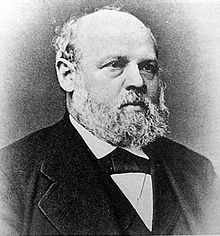| Heinrich Geissler | |
|---|---|
 Heinrich Geissler Heinrich Geissler | |
| Born | 26 May 1814 Igelshieb, Thuringia, Saxe-Meiningen |
| Died | 24 January 1879 (1879-01-25) (aged 64) |
| Nationality | German |
| Known for | Geissler tubes |
| Scientific career | |
| Fields | Physics |

Johann Heinrich Wilhelm Geißler (26 May 1814 in Igelshieb – 24 January 1879) was a skilled glassblower and physicist, famous for his invention of the hand pumped Geissler mercury vacuum pump in the mid-1850's and in 1857, the Geissler tube, made of glass and used as a low pressure gas-discharge tube; these two inventions were critical technologies leading to the discovery of the electron.
Geissler descended from a long line of craftsmen in the Thüringer Wald and in Bohemia. He found work in different German universities, eventually including the University of Bonn. There he was asked by physicist Julius Plücker to design an apparatus for evacuating a glass tube.
Plücker owed his forthcoming success in the electric discharge experiments in large measure to his instrument maker, the skilled glassblower and mechanic Johann Heinrich Wilhelm Geissler. He learned the art of glassblowing in the duchy of Saxe-Meiningen.... He finally settled down as an instrument-maker in a workshop of his own at the University of Bonn in 1852.
The Geissler tube was used for entertainment throughout the 1800s and evolved around 1910 into commercial neon lighting. Advances in Plucker and Geissler's discharge tube technology developed into the Crookes tube, with which the electron was discovered in 1897, and in 1906 into the amplifying vacuum tube, the basis of electronics and long-distance communication technologies like radio and television.
Geissler was awarded an honorary doctorate in 1868.
References and articles
- "Gas discharge tube with exchangeable holder — Teylers Museum". www.teylersmuseum.nl. Retrieved March 15, 2024.
- Pais, Abraham (2002). Inward bound: of matter and forces in the physical world (Reprint ed.). Oxford: Clarendon Press ISBN 978-0-19-851997-3.
- ^ Per F. Dahl, Flash of the cathode rays: a history of J.J. Thomson's electron. CRC Press, 1997, pp.49–52 .
- Publications
- Miller, H. A. (1945). Luminous tube lighting, dealing with the principles of the luminous tube, with a summary of the materials and equipment involved, and technical data concerning discharge-tube light sources. London: G. Newnes.
- Kassabian, Mihran Krikor Roentgen rays and electro-therapeutics: with chapters on radium and phototherapy. Publisher: J.B. Lippincott Company Philadelphia & London, 1910 - Lippincott's New Medical Series. Edited by Francis R. Packard, M.D
- Davis, H. B. O. (1981). Electrical and electronic technologies: a chronology of events and inventors to 1900. Metuchen, N.J.: Scarecrow Press.
- Phillips, C. E. S. (Charles Edmund Stanley): Bibliography of X-ray literature and research, 1896–1897: being a ready reference index to the literature on the subject of roentgen or X-rays. Publisher: The Electrician Print. and Pub. Co., London 1897
- Heinrich Geissler 1838, page 16, Historical Retrospect in: Charles E. S. Philips
External links
- The Cathode Ray Tube site
- Heinrich Geissler Biography - The Cathode Ray Tube site
- Spark Museum, Crookes and Geissler Tubes
- Geissler, Johann Heinrich Wilhelm in: Complete Dictionary of Scientific Biography Charles Scribner's Sons, 2008
- Geisslerhaus Museum
- Electrical tubes in the Museum of Science and Industry, London
- 1857 – Julius Plücker, Heinrich Geißler und der Beginn systematischer Gasentladungsforschung in Deutschland in: NTM International Journal of History & Ethics of Natural Sciences, Technology & Medicine, Volume 14, Issue 1, pp 26–45